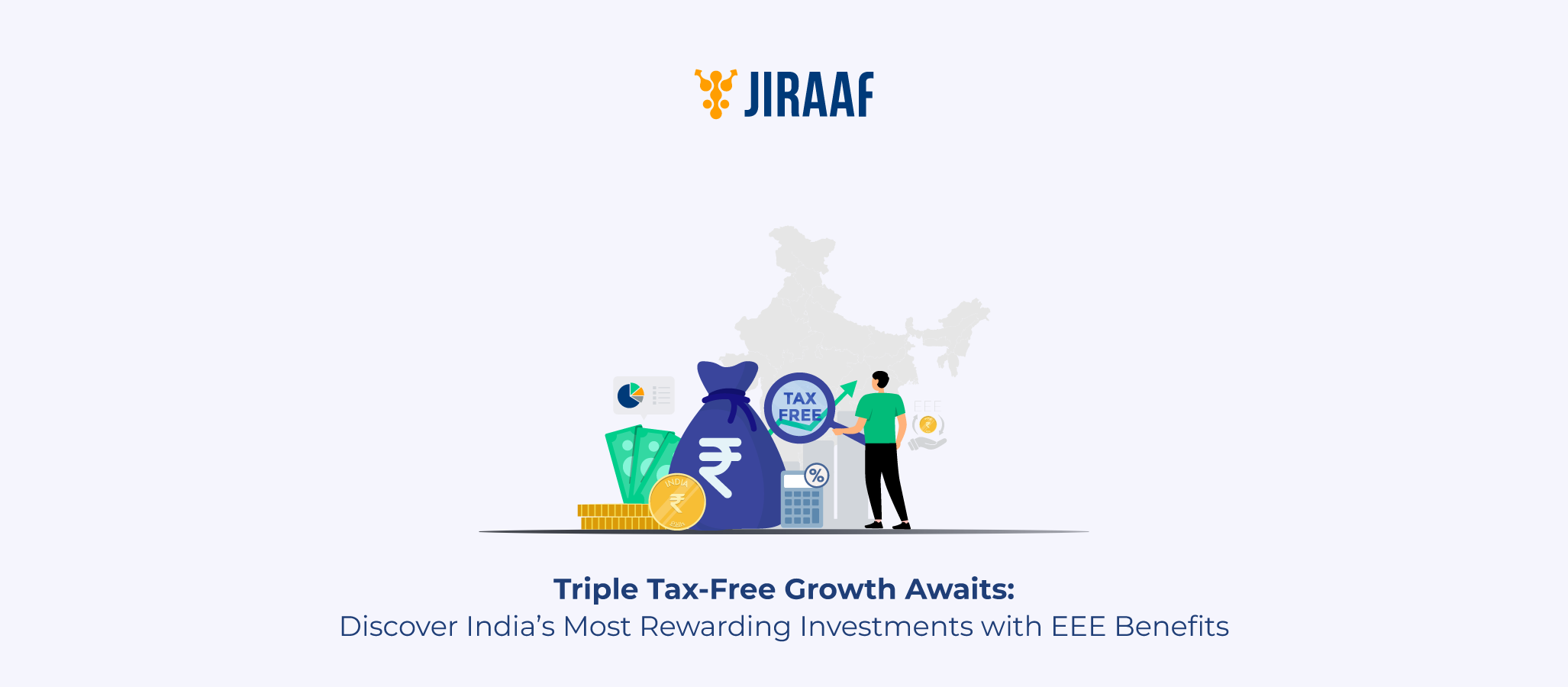When you’re mapping out your tax-saving journey, you’ll likely come across various tax regimes like EEE, EET, and TEE. Among them, the EEE or Exempt-Exempt-Exempt tax regime is considered the gold standard for long-term, tax-efficient investing in India.
But what does EEE really mean? How does it work, and which investment options qualify for it?
In this guide, you’ll understand the meaning of EEE, explore the top investment options that fall under this regime, and get practical tips to optimize your tax-saving strategy using EEE instruments. Let’s dive in.
What Is EEE in Taxation?
EEE stands for Exempt-Exempt-Exempt, and it refers to a type of tax treatment where:
- Your investment (contribution) is tax-deductible
- The interest earned is tax-free, and
- The maturity or withdrawal amount is also tax-exempt.
This triple exemption makes EEE investments extremely popular among long-term savers and those looking to maximize their post-tax returns.
EEE vs. EET vs. TEE: A Quick Look
Let’s see their differences side-by-side.
| Tax Regime | Contribution | Growth | Withdrawal |
| EEE | Exempt | Exempt | Exempt |
| EET | Exempt | Exempt | Taxable |
| TEE | Taxed | Exempt | Exempt |
With EEE, you’re saving taxes at all three stages—making it the most tax-advantaged model for Indian taxpayers.
How Does EEE Work?
Let’s break this down using an example.
Suppose you invest ₹1,50,000 annually in a Public Provident Fund (PPF).
- You get a deduction of ₹1.5 lakh under Section 80C.
- The annual interest earned (say 7.1%) is completely tax-free.
- After 15 years, the maturity amount is also exempt from tax.
Now imagine compounding that for 15 years—the tax savings alone could amount to lakhs of rupees over time.
Top EEE Investment Options in India (FY 2025–26)
| Parameter | PPF | EPF | SSY | Life Insurance/ULIP | NPS | ELSS |
| Eligibility | Resident individuals | Salaried employees (EPFO) | Girl child (below 10 years) | All individuals | Indian citizens (18–70 years) | Individuals & HUFs |
| Lock-in/Tenure | 15 years (extendable) | Till retirement/job change | 21 years or until marriage after 18 | Min 5 years (varies) | Till age 60 | 3 years |
| Annual Contribution Limit | ₹500–₹1.5 lakh | 12% of basic salary | ₹250–₹1.5 lakh | ₹1.5 lakh (for 80C) | ₹2 lakh (₹1.5L under 80C + ₹50K under 80CCD) | ₹1.5 lakh (for 80C) |
| Return Type | Fixed (govt. notified) | Fixed (govt. notified) | Fixed (govt. notified) | Traditional – FixedULIPs – Market-linked | Market-linked (Equity + Debt) | Market-linked (Equity) |
| Interest Rate (Approx.) | ~7.1% | ~8.15% | ~8.2% | 4–6% (Traditional)8–12% (ULIP) | ~9–11% (varies by scheme) | ~10–15% (historical) |
| Tax Benefit | 80C | 80C | 80C | 80C & 10(10D) | 80C, 80CCD(1B), 80CCD(2) | 80C |
| Risk Level | Very Low | Low | Very Low | Low to Moderate | Moderate | High |
| Liquidity | Partial after 5 years | Partial under conditions | 50% after girl turns 18 | Low (surrender charges apply) | Partial after 3 years (specific needs) | Redeemable after 3 years |
| Maturity Tax Status | Fully tax-free | Tax-free after 5 years | Fully tax-free | Fully tax-free (if <10% of sum assured) | 60% tax-free; 40% taxable via annuity | ₹1L LTCG exempt; excess taxed @10% |
Important Update
- For EPF, interest earned on contributions above ₹2.5 lakh a year is now taxable. For most salaried employees, EPF remains EEE only up to this threshold.
- For ULIPs, if the annual premium exceeds ₹2.5 lakh (across all ULIPs), maturity proceeds are taxable as capital gains.
- For NPS, only 60% of the corpus withdrawn at retirement is tax-free; the remaining 40% must be used to purchase an annuity, which is taxable as per your income slab.
Benefits of Investing in EEE Instruments
Let’s break it down.
| Benefit | Explanation |
| Triple tax saving | No tax on entry, accumulation, or exit |
| Long-term wealth creation | Compounded growth over 15–25 years |
| Risk-free or low-risk options | Most are government-backed (PPF, EPF, SSY) |
| Retirement planning support | EPF, PPF, and NPS help secure your post-retirement life |
| Encourages disciplined investing | Lock-in periods prevent impulsive withdrawals |
An Example of How EEE Can Help You Save Big
Scenario
Ravi, a 30-year-old salaried employee, contributes the following every year:
- ₹1,50,000 in PPF
- ₹50,000 in NPS (80CCD(1B))
- ₹30,000 in Life Insurance Premium
Over 20 years
- Total Investment: ₹46 lakh
- Tax saved (at 30% slab): ~₹13.8 lakh
- Maturity value (at 7% avg. return): ~₹1.05 crore
- Tax paid on maturity: ₹0
This is the power of compounding combined with EEE.
Points to Consider Before Choosing EEE Instruments
Lock-in Periods Are Long
PPF: 15 years
SSY: 21 years
EPF: Until retirement
If liquidity is a concern, consider diversifying with ELSS or ULIPs (3–5 year lock-ins).
Annual Contribution Caps
Most instruments allow only ₹1.5 lakh per year under Section 80C. If you’ve already exhausted this, additional investment may not fetch more tax benefits.
Returns May Be Moderate
While EPF and SSY offer solid interest, they may not beat inflation significantly in the long run. Pair them with ELSS or NPS for higher growth potential.
Tax Norms Can Change
Stay updated on tax rule changes in the budget. For instance, ULIPs above ₹2.5 lakh in premium lost their tax-free status recently.
EEE Investment Comparison Table
| Instrument | Lock-in | Risk Level | Interest/Returns | Tax Benefit | Ideal For |
| PPF | 15 yrs | Very Low | ~7.1% | EEE | Conservative savers |
| EPF | Retirement | Low | ~8.15% | EEE | Salaried employees |
| SSY | 21 yrs | Very Low | ~8.2% | EEE | Girl child’s future |
| Life Insurance | 5 yrs+ | Very Low | Varies (ULIP 6–10%) | EEE | Family protection |
| ULIP | 5 yrs | Moderate | 6–12% | EEE | Market-savvy investors |
| ELSS | 3 yrs | High | 10–15% (market-linked) | Semi-EEE | Young investors |
EEE vs EET vs TEE: What Should You Choose?
- EEE: Best for long-term, secure wealth creation
- EET: Good for retirement, but expect tax at withdrawal (e.g., NPS annuity)
- TEE: Short-term tools like mutual funds or stocks
Blend them based on your financial goals, age, and risk tolerance.
Smart Planning Tips
- Max out your 80C first. PPF + Life Insurance + ELSS = strong combo.
- Use NPS for additional deduction. Claim extra ₹50,000 under 80CCD(1B).
- Consider SSY if you have a daughter. Best post-tax returns for a girl child’s future.
- Don’t overcommit to lock-ins. Ensure liquidity by balancing with mutual funds
- Start early. Even ₹5,000/month in PPF started at age 25 can grow to over ₹25–30 lakh by the time you’re 45.
Why EEE Should Be a Key Part of Your Portfolio
Last but not least, the EEE regime is more than a tax-saving strategy; it’s a financial planning philosophy. By consistently investing in EEE-compliant instruments, you build a portfolio that’s not only secure and long-term-focused but also tax-optimized from start to finish.
And the best part? The government is encouraging you to do it with triple tax benefits as your reward.
So, if you haven’t already, start aligning your tax plan with the EEE approach. Your future self (and your tax returns) will thank you.
FAQs
What is EEE in taxation?
EEE stands for Exempt-Exempt-Exempt. It means your investment, the interest earned, and the maturity amount are all exempt from tax. This makes it one of the most tax-efficient models in India.
Which investments qualify for EEE tax status?
Investments like Public Provident Fund (PPF), Employee Provident Fund (EPF), Sukanya Samriddhi Yojana (SSY), life insurance (with conditions), and ULIPs qualify under the EEE regime.
Is ELSS an EEE investment?
Partially. ELSS is tax-free at the investment stage (under 80C), and long-term capital gains up to ₹1 lakh/year are tax-free. Gains above ₹1 lakh are taxed at 10%.
Can I invest in multiple EEE instruments at once?
Yes, you can. But the maximum deduction under Section 80C remains ₹1.5 lakh. You can split that across PPF, ELSS, SSY, life insurance, etc.
Is NPS fully EEE?
Not entirely. While contributions and partial withdrawals are tax-free, annuity payouts post-retirement are taxable. So, it’s a hybrid EEE/EET model.
Discover fixed income investments with Jiraaf, a SEBI registered online bonds platform that educates and brings access to a wide array of bonds. Sign up today to explore diversified fixed income investment opportunities to support your goal-based wealth creation journey. Start investing!



